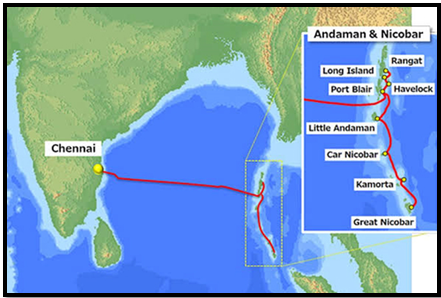TRADE-OFF: DEVELOPMENT AND ENVIRONMENTAL LOSS IN GREAT NICOBAR ISLAND
Syllabus:
- GS-3– Great Nicobar island as a geostrategic and environmentally important location Economic development of the region
Focus :
- This article explores the contentious approval of a trans shipment port in Great Nicobar Island’s Galathea Bay. It highlights the environmental implications of denotifying a wildlife sanctuary, examining the bureaucratic and legal maneuvers that facilitated the project, and the ongoing conflict between development and conservation.
Source-TH
Introduction
- Context of the Project: The article opens with an analogy about urban land misuse to set the stage for the main discussion.
- Issue Overview: The focus is on the controversial approval of a Rs 42,000 crore transshipment port in Great Nicobar Island’s Galathea Bay, a region rich in biodiversity and designated as a Coastal Regulation Zone (CRZ) IA.
Coastal Regulation Zone (CRZ) IA
- Definition: CRZ-IA includes areas like wildlife sanctuaries and national parks, mangroves, coral reefs, and other ecologically sensitive regions.
- Regulations: Large construction projects are prohibited in CRZ-IA areas to protect the environment.
Environmental Significance of Galathea Bay
- Leatherback Turtles: Galathea Bay is a crucial nesting site for the world’s largest sea turtle, the giant leatherback, and three other species.
- Coral Colonies and Mangroves: The bay houses significant coral colonies and mangroves, contributing to marine biodiversity.
- Nicobar Megapode: The coastal forests around the bay are important nesting sites for the endemic Nicobar megapode.
Denotification of Galathea Bay Wildlife Sanctuary
- Original Protection: Galathea Bay was proposed as a wildlife sanctuary in 1997 to preserve its ecological richness.
- Denotification: Despite ongoing nesting by turtles and other ecological activities, the sanctuary was denotified in January 2021.
Environmental Clearance for the Port Project
- Approval Process: The Ministry of Environment, Forests and Climate Change (MoEFCC) granted clearance for the port project in November 2022.
- Conflict of Interest: The clearance process involved the MoEFCC, which both regulates and grants environmental clearances, raising concerns about impartiality.
Legal and Administrative Challenges
- National Green Tribunal (NGT) Involvement: The NGT challenged the clearance, noting the presence of coral colonies and the CRZ-IA status of the project site.
- High-Powered Committee (HPC): The NGT appointed an HPC, headed by the Secretary, MoEFCC, and including the Chief Secretary, Andaman and Nicobar Islands.
Conflict of Interest in the HPC
- ANIIDCO’s Role: The Chief Secretary is also the chairman of ANIIDCO, the project proponent, leading to potential bias in the review process.
- MoEFCC’s Dual Role: The MoEFCC, which granted the clearance, was also part of the committee reviewing the challenge to its own decision.
Scientific and Regulatory Anomalies
- NCSCM Report: The National Centre for Sustainable Coastal Management (NCSCM) conducted a ground-truthing survey.
- Reclassification: Based on the survey, it was concluded that the project area falls under CRZ-IB, where construction is permissible, not CRZ-IA.
Environmental Reality vs. Legal Definitions
- Ecological Presence: Despite legal reclassification, the ecological features that originally qualified the area as CRZ-IA remain intact.
- Legal Maneuvers: The reclassification appears to be a legal workaround to facilitate the port project, ignoring scientific and ecological realities.
- Impact on Local Biodiversity: Detailed discussion on how the project affects various species and habitats.
- Community and Stakeholder Views: Perspectives of local communities, environmentalists, and developers.
- Comparative Analysis: Similar cases in India and globally, examining how different regions handle such conflicts.
- Future Outlook: Potential long-term consequences of the project and what steps can be taken to mitigate environmental damage.
Broader Implications
- Development vs. Conservation: The case exemplifies the ongoing tension between developmental aspirations and environmental conservation in India.
- Policy and Governance: It raises questions about the effectiveness of environmental policies and the integrity of the clearance processes.
Conclusion
- The article ends with a critique of the legal and administrative processes that allowed the project to proceed, emphasizing the need for a balanced approach to development and environmental protection.
Associated Article
Mains UPSC Question
GS 3
Discuss the implications of the recent environmental clearance granted for the transshipment port in Great Nicobar Island on the local ecosystem and the procedural anomalies associated with it. How does this case reflect the broader challenges in balancing development and environmental conservation in India?(250 words)




